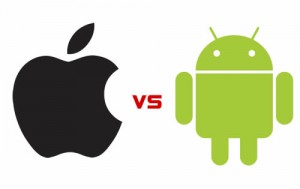 The two headliners of the smartphone platform are Android and iOS. These two have reached ahead of the competition for numerous reasons and are the most sought after in the market. Moreover, numerous Apps are available for both these platforms. Although, between the two of them, it is not that difficult to find a winner. Let us explore the different development features of both platforms:
The two headliners of the smartphone platform are Android and iOS. These two have reached ahead of the competition for numerous reasons and are the most sought after in the market. Moreover, numerous Apps are available for both these platforms. Although, between the two of them, it is not that difficult to find a winner. Let us explore the different development features of both platforms:
Apps Writing
To develop apps for iOS and list them on the App store is very expensive. It costs about $99 per year and you have to adhere to some strict rules and regulation put in place by Apple. Your app also has to pass a screening process before it can be released Developing apps for the Android Phone is comparatively cheaper and less restricted by rules. Google simple takes a $25 flat fee to shelf your apps, plus an extra $20 if you plan to charge for its usage. Android has a larger market, meaning other app stores are visible for you to display your wares.
Language
Writing apps for iOS means you have to use Objective-C, which is a very dynamic, object-oriented programming language. It is used for writing Mac apps.  Once you download the free Xcode installer from the Mac App Store, you can begin writing code. Android developers are given more freedom to choose the language they want to base their apps on. For instance, you can use either Java (a widely incorporated language) or C/C++ to build your apps. It has been speculated by an online blogger that the reason behind Apple’s dependency on Obj-C is to attract only the best and brightest app developers. It is far easier to develop apps for the Android stores; it supports HTML, JavaScript, Ruby and SQL.  Since the development and entry of the apps is so simple, a lot of amateurish apps are on the Android Stores.  Android requires users to ‘Download the SDK’, setup ‘Eclipse’ and then, install Google’s ADT Plugin.
Different Phones
Developers know what their app will look like on an iOS platform as the iPhone and Ipad have known screen dimensions. There is no worry about fixing the app to accommodate different screen dimensions. Such a privilege is riddled with uncertainty for Android developers. The screen resolution and dimensions vary over different kinds. The app developers have to think about the different dimensions in the market and how each of them will project their app. It is an issue seeing as buyers will be annoyed that some apps function on certain phones and not others. Finally iOS apps are considered to be more beautiful and practical than Android apps, which is why  users often settle for them. However, Android appears to be growing, seemingly attempting to cross barriers and reach the market. Nevertheless, it is difficult to foresee a winner as each have commendable and attractive products in their own right.  If there will be a winner, it will be because one of the platforms has taken a critical misstep in its strategy. Until then, it is a very close race.
Robert is one of the contributor for Credit Cards Canada where you may find some great information on secured credit cards .
Originally posted on October 19, 2011 @ 6:32 am